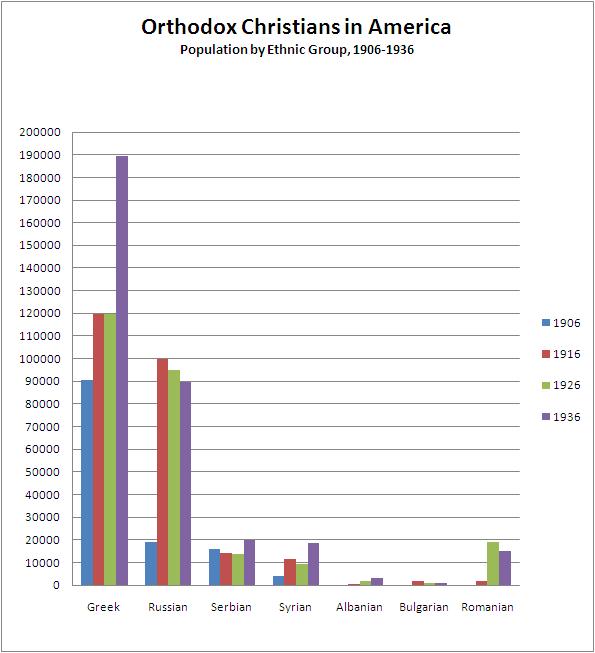Every ten years, from 1906 to 1936, the US Census Bureau compiled a Census of Religious Bodies. These censuses are gold mines of information on early American Orthodoxy. Also, unlike so many of the inflated numbers that you’re likely to see floating around, the census data is reliable. With its considerable resources, the Census Bureau was able not only to work with the jurisdictions themselves, but to contact individual parishes for precise information. The result is a thorough, well-researched, and generally unbiased collection of statistics and other information.
What can we learn from the censuses? Loads of things. For instance, we can track the growth of the various Orthodox groups and jurisdictions in the United States:
The Russian spike in 1916 was most likely caused by Uniate conversions. Overall, the Orthodox population grew from about 130,000 in 1906 to almost 350,000 thirty years later:
- 1906: 129,606
- 1916: 249,840
- 1926: 259,394
- 1936: 348,025
As you can see, the 1916-1926 period was rather stagnant; in fact, aside from the Albanians and Romanians, every jurisdiciton declined in that period. World War I probably had something to do with it, as well as the new immigration quotas imposed by the US government in 1924. It’s also likely that the various jurisdictional schisms of the 1920s — Russy-Antacky, Royalist-Venizelist, Metropolia-Living Church — affected the ability of the Census Bureau to collect data. (That is, there were probably more Orthodox than were reported in 1926.)
One of the things I’ve found most interesting about the census data are the gender ratios. In 1906, men represented 85% of all American Orthodox Christians. That is, for every woman, there were almost six men. Here are the percentages of women in each year:
- 1906: 15%
- 1916: 28%
- 1926: 40%
- 1936: 46%
By 1936, every group was between 42 and 51 percent female. For most of this period, the Greeks were the most overwhelmingly male jurisdiction (with female percentages from 1906-36 of 6, 17, 34, and 43 percent). Until ’36, the Syrians were the most balanced group, with 40% women in 1906, and 45, 49, and 47 percent in the years that followed.
The Serbian male population actually declined considerably from 1906-26, due most likely to the Balkan Wars and then World War I, but the female population (not just the percentage) increased dramatically:
- 1906: 2,228 women (14%)
- 1916: 3,301 women (23%)
- 1926: 6,421 women (47%)
The census also kept data on Sunday schools. In 1906, there were just 7 Sunday schools in all of American Orthodoxy. By 1916, there were 162 (of which 126 were Russian). The Russians actually closed a lot of their Sunday schools in the next decade (dropping to 90), but the Greeks and Romanians added a lot more, pushing the total number up to 198 by 1926. By 1936, there were 294 Orthodox Sunday schools in the United States, of which 129 were Greek and 101 were Russian.
I’ve barely scratched the surface of what’s available in the censuses. In the future, we’ll continue to unpack the data.

Dear Matthew,
I’d love to see the actual data.
Have you published it somewhere that i’m not seeing?
Thanks
Dean Calvert
Dean,
All the data comes from the Censuses of Religious Bodies, conducted by the US Census Bureau in 1906, 1916, 1926, and 1936. All but the 1926 Census are fully digitized and available online (the ’26 Census is, as best I can tell, only partially digitized). However, you can see the ’26 data (as well as data from ’06 and ’16) in the 1936 Census, which you can access by clicking here. The different years are available on various websites — the Census Bureau site, Google Books, and the Internet Archive (archive.org), I think.
Matthew